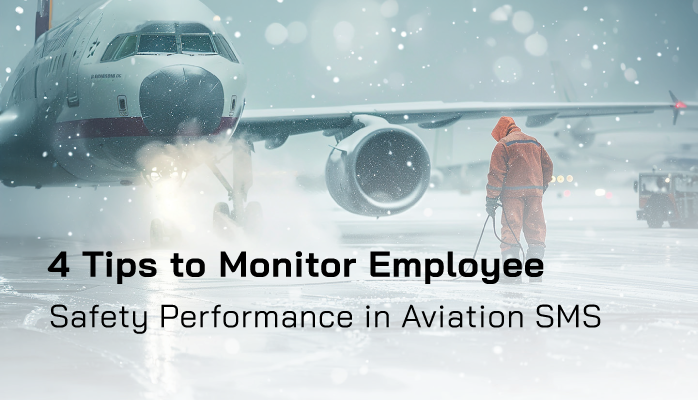Aviation Safety Performance Begins at the Lowest Level

80% of aviation service providers have trouble getting employees to participate in aviation safety management systems (SMS).
Most safety managers accept this challenge and strive to implement consistent safety promotion activities, such as
- Safety newsletters;
- Safety surveys; and
- Safety meetings.
Have you noticed that these safety promotion activities are sadly short-lived and lack "motivational power?" Besides taking a safety survey and safety meeting attendance, there is little motivation for employees to regularly participate in the SMS.
We will discuss several "non-intrusive" techniques requiring little managerial effort to monitor employee safety performance and to motivate employees to remain engaged in the aviation SMS.
Have You Read
- Why Employees Don't Care About Your Aviation SMS
- How to Engage Difficult Employees in Aviation SMS
- My Safety Score - What's Yours? Safety Performance Monitoring for Aviation SMS
Zero Performance When Nobody Is Watching
The Japanese culture is admirable to many of us in Western culture. Compared to our society, the Japanese appear very well-behaved. During a natural disaster, you don't see looting like you do in the southern United States or Latin American countries.
We attribute the high social standards to something internal, something special that is taught at an early age. Observations regarding Japanese strict obedience to traffic laws shed some light on the Japanese culture and stereotype of abject obedience. I'm unable to find the source of an article I read a couple of years ago, but one study found that the Japanese will obey rules and regulations only if there is a possibility of getting caught.
In short, when there is little chance of being caught violating a traffic rule, the Japanese behave similarly to the rest of us.
What does this have to do with monitoring employee safety performance?
Employees Will Participate When They Feel Someone Is Watching

At almost every aviation service provider's company, there lacks an ability for management to easily monitor employees' attitudes and behaviors toward their mandated SMS. I cannot say every company, because I know a few companies with tools to easily monitor employee safety performance.
When employees know that management has tools to monitor their behaviors then employees will shift their behaviors to align with management's expectations. For example, when employees know that there are "porn alerts" on the network servers that alert managers of suspicious Internet activity with the ability to track the source, there is very little chance that employees will visit porn sites at work.
What Types of Safety Activities Can Be Monitored
Depending on your aviation safety database, there may be many items that can be tracked, such as
- Number of reported issues vs. average number of reported issues per employee;
- Number of logins to employee safety program vs. company average;
- Whether they reading and acknowledging safety messages in a timely manner?
- Date employee last logged into the safety portal; and
- How many on-time safety tasks vs. overdue tasks were completed by the employee?
What I believe is important is that the employees know that management is tracking this information. When employees know that management is not using this information, you are simply wasting your time collecting this valuable safety performance monitoring data.
Related Aviation SMS Performance Monitoring Articles
- 4 Pillars | How to Conduct Safety Performance Monitoring and Measurement
- 5 Useful Safety Performance Monitoring Tools in Aviation SMS
- How to Be Compliant With ICAO Safety Performance Monitoring and Measurement
Tying Safety Performance Data to Employee Goals or Objectives
Employees have goals and objectives that are important to them. For example:
- Keeping their jobs (sometimes);
- Earning more money (raises); and
- Advancing their careers (moving up the ladder).
Furthermore, most companies have formal employee performance reviews that are documented by their immediate manager. Whenever an employee's immediate manager has easy access to employee safety performance data, there is a higher likelihood that employees will engage in a desirable behavior.
What is even sweeter is when managers have access to document notes regarding past behavior, such as an employee's personal "safety plan." This tactic will most certainly allow management to follow up with employees should an employee receive a less-than-stellar safety review.
How to Track Employee Safety Performance Data

Based on the workflows described above, the most interested safety manager will be asking how to track all these data metrics. What is the best technology to implement an employee safety performance monitoring program? There seem to be a lot of moving parts here. Let's quickly review the possible variables you will need to track: Define Activity to Track - Employee Hazard Reporting Performance.
The activity you want to track is dependent on your safety goals and objectives. If you need to increase proactive hazard reporting numbers, then you will need to track how many issues an average employee reports. For example, a healthy safety reporting culture will receive a monthly report for every ten employees. In this case, you need to track how many reported issues were submitted by each employee within a predefined time period, such as one calendar year. You will need a list of employees and a count of their reported issues within a predefined date range.
In this case, we need to track:
- Reported issues;
- Reporter information;
- Date submitted; and optionally
- Were any of the reported issues significant?
The last point is noteworthy in that the quality of an employee's reported issue may outweigh the volume of the reported issue.
From this example, we have only a few data points we need to track. A spreadsheet will not work in this case to store the raw data and to retrieve and share employee performance results. If you think a spreadsheet will work, let's take a quick look at a proposed workflow to use a spreadsheet.
The safety manager opens a spreadsheet. He creates a list of all employees in the company, or in his department. For each employee, he then opens up his hazard reporting spreadsheet and counts all the reported issues that fall within his desired date range, such as the past six months or one year. The safety manager enters the number of reported issues submitted by the employee. Once complete, the safety manager sends the spreadsheet to the employee's supervisor to use during the routine employee performance review.
If you have been following closely, you can quickly see this is a lot of work using spreadsheets and this is not a sustainable solution. It may work in a company with 20 employees. The moral of the story, you don't want to monitor employee safety performance using a spreadsheet. It is not sustainable and complications arise when trying to prepare the data and share it with other managers.
The proper technology to track employee safety performance data is an SMS database.
Related Aviation SMS Database Articles
- What Is an Aviation Safety Database
- How to Choose the Best Aviation Safety Database Software
- 3 Things to Know Before Buying Aviation SMS Database
When Management Wants to Sincerely Improve Safety Performance
When upper management wants to sincerely improve organizational safety performance, you will have to tell them you need an SMS database to efficiently
- Aggregate safety activity data;
- Monitor data points based on goals and objectives;
- Create safety reports;
- Share safety data among other managers; and
- Allow managers to update employees' action plans should the employee need "special help."
If you cannot measure a particular safety behavior, you cannot monitor it. If you cannot monitor safety behavior, you will not be able to react appropriately in a timely manner should small adjustments be required.
If management is sincere about safety performance, the safety manager will need to educate management that specialized tools are required to monitor and make appropriate decisions.
Final Thoughts on Employee Safety Performance Monitoring
Monitoring employee safety performance is extremely effective in turning around your safety culture. Instead of having 80% of employees inactive in your SMS program, you can expect that rate to drop to below 20%.
In order to be effective, you will need:
- Tools to easily capture and safety performance data;
- Top management support for the program;
- Employee awareness of the safety performance monitoring;
- Sensitivity in selecting which data elements to capture; and
- Easy access to reports by managers.
Instead of throwing up your arms and saying, "How can I get employees involved," you can now go to management and say, "Mr. Accountable Executive, we have a problem with employees participating in your SMS. Here is a sustainable solution..."
Good luck.
Learn how an SMS database can help you involve employees in aviation SMS. There is a solution and I have seen it work.
To see a great example of tools to monitor safety performance, see
Last updated in April 2025.









